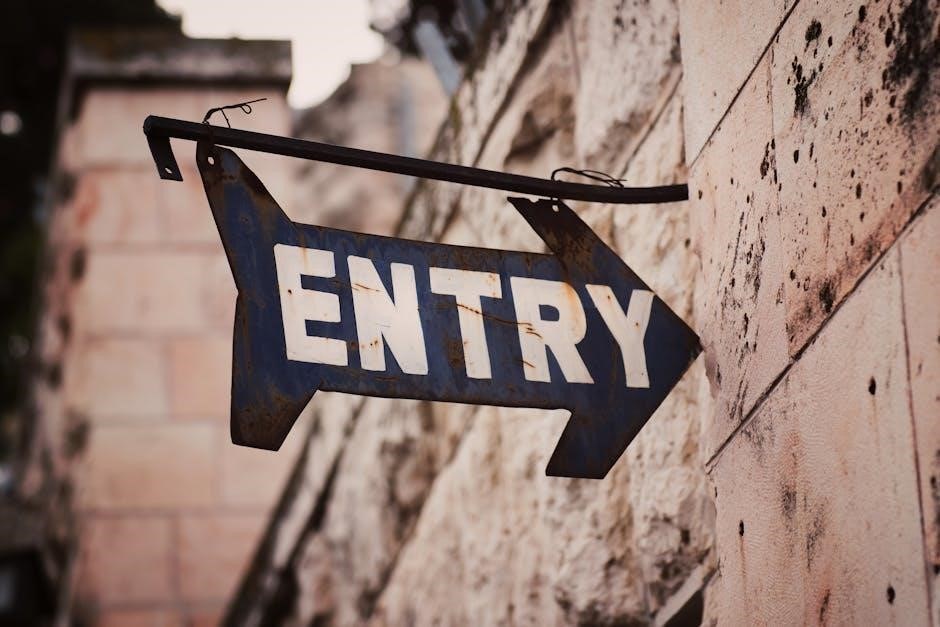Building regulations set minimum standards for safety, health, and sustainability in construction. Electricians must comply to ensure installations meet legal requirements, avoiding penalties and ensuring safety.
Overview of Building Regulations
Building regulations are a set of rules ensuring that construction projects meet minimum safety, health, and sustainability standards. These regulations cover various aspects of building, including electrical installations. For electricians, compliance with these regulations is crucial to avoid penalties and ensure the safety and longevity of electrical systems. Non-compliance can lead to legal issues and potential hazards, making adherence essential. The regulations are regularly updated, so staying informed is vital for professionals to maintain compliance and deliver high-quality work.
Importance of Compliance for Electricians
Compliance with building regulations is vital for electricians to ensure electrical installations are safe, efficient, and meet legal standards. Non-compliance can result in penalties, legal action, and safety hazards. Adhering to regulations protects both the electrician and the client, ensuring installations are reliable and durable. Compliance also enhances professional reputation and trust. Electricians must stay updated on regulations, such as RCD protection and fire safety requirements, to maintain high standards and avoid potential risks. Proper compliance ensures electrical systems are safe, functional, and meet all necessary codes.
Key Areas Covered in the Guide
The guide covers essential topics for electricians, including Part P requirements, safety standards, RCD protection, fire safety, and necessary documentation. It provides insights into third-party certification and inspection procedures to ensure compliance. The guide helps electricians navigate complex regulations, avoid penalties, and ensure safe, efficient installations that meet legal standards. It serves as a comprehensive resource for both domestic and commercial installations, offering detailed information to support professional practice and adherence to building regulations.

History and Evolution of Building Regulations
Building regulations have evolved over decades, from basic safety standards to comprehensive guidelines. Key milestones include the 18th Edition IET Wiring Regulations and updates to Part P requirements.
Development of Building Regulations in the UK
The development of UK building regulations began in the 20th century, focusing on safety and structural integrity. The 1985 Building Act introduced approval routes, ensuring compliance with safety standards. Electricians must adhere to these regulations, particularly Part P, which governs electrical installations in dwellings. The 18th Edition IET Wiring Regulations further refined electrical safety standards, emphasizing RCD protection and fire safety. These updates ensure installations are safe, efficient, and meet legal requirements, safeguarding both properties and occupants while preventing potential hazards.
Major Updates and Revisions
Building regulations have undergone significant updates, with key revisions in 2005 introducing Part P for electrical installations in dwellings. The 18th Edition IET Wiring Regulations, effective from 2018, brought major changes, including mandatory RCD protection for mobile outdoor equipment and enhanced fire safety standards. These updates reflect the evolving needs for safety, efficiency, and sustainability. Electricians must stay informed to comply with the latest requirements, ensuring installations meet current standards and avoid penalties. These revisions emphasize the importance of adherence to safeguard people, property, and the environment.
Impact of the 18th Edition IET Wiring Regulations
The 18th Edition introduced significant changes, mandating RCD protection for mobile outdoor equipment and enhancing fire safety standards. It emphasized Arc Fault Detection Devices for solar installations and updated cable sizing calculations. These changes ensure safer electrical installations and compliance with current standards. Electricians must adhere to these regulations to avoid penalties and ensure installations meet safety and efficiency requirements. The 18th Edition reflects the evolving industry needs, prioritizing safety and sustainability in all electrical work.

Part P: Fixed Installations in Dwellings
Part P ensures electrical installations in homes meet safety standards, covering circuits, RCD protection, and certification. Compliance is crucial for electricians to avoid penalties.
Scope and Requirements of Part P
Part P regulates electrical installations in dwellings, ensuring safety and compliance. It covers circuits, RCD protection, and certification, with specific requirements for design, installation, and testing. Electricians must adhere to these standards to avoid penalties and ensure installations meet legal and safety benchmarks. Proper documentation and compliance with Part P are essential for maintaining electrical safety and avoiding legal repercussions. The scope includes all fixed electrical installations, emphasizing protection against fire and electric shock risks. Compliance ensures installations are safe, durable, and meet current regulatory demands.
Compliance Guidelines for Electricians
Electricians must adhere to Part P regulations, ensuring all electrical work in dwellings meets safety and legal standards. This includes using approved materials, installing RCD protection, and conducting proper testing. Documentation, such as certificates, is mandatory for compliance. Non-compliance can result in penalties, including fines and legal action. Electricians should stay updated on regulatory changes and consider third-party certification schemes to demonstrate adherence to standards. Regular inspections and adherence to safety protocols are essential to maintain compliance and avoid penalties. Proper training and knowledge of Part P are critical for electricians to ensure safe and lawful installations.
Third-Party Certification Schemes
Third-party certification schemes provide independent verification of electrical work compliance with Building Regulations. These schemes enhance credibility and ensure installations meet safety and quality standards. electricians can join such programs to demonstrate adherence to Part P and other regulations. Certification offers proof of competence, reducing the need for local authority inspections. Schemes also provide guidance on compliance, helping electricians navigate complex regulations. Participation involves regular audits and assessments, ensuring ongoing adherence to standards. These schemes are invaluable for maintaining trust and ensuring safe, lawful electrical installations.

Safety Standards and Regulations
Safety standards ensure electrical installations meet strict criteria to protect people and property. Compliance with regulations like RCD protection and fire safety is essential for hazard prevention and legal adherence.
General Safety Standards for Electrical Work
General safety standards for electrical work ensure installations are safe, reliable, and compliant with legal requirements. These standards cover RCD protection, proper insulation, and safe voltage levels. They also address fire risks, overload protection, and earthing systems. Compliance with IET Wiring Regulations and regular inspections are essential. Electricians must follow these guidelines to prevent hazards and ensure longevity of installations. Non-compliance can lead to penalties and safety risks, making adherence crucial for protecting people and property. These standards form the foundation for all electrical work, ensuring safety and reliability in every installation.
RCD Protection Requirements
RCD protection is critical for electrical safety, detecting and interrupting dangerous fault currents. Regulations mandate RCDs in specific circuits, such as those supplying bathroom or outdoor equipment. They must have a maximum sensitivity of 30mA and a response time under 40ms. Proper installation and testing ensure RCDs function correctly, preventing electric shock and fatalities. Non-compliance can lead to severe penalties and increased risk of accidents. Regular maintenance and testing are essential to uphold safety standards and protect users from electrical hazards in all settings, domestic or commercial.
Fire Safety Regulations for Electrical Installations
Fire safety regulations for electrical installations aim to minimize fire risks and ensure occupant safety. They specify requirements for materials, design, and installation practices. Flame-retardant materials and proper cable management are essential. Regular inspections and testing of electrical systems are mandated to identify potential fire hazards; Emergency lighting and fire alarm systems must be integrated with electrical installations. Compliance ensures the safety of buildings and their occupants, preventing fire-related incidents and fatalities. Adhering to these regulations is critical for electricians to maintain legal and safety standards in all types of premises.

Electrical Installations in Dwellings
Electrical installations in dwellings require careful planning, design, and execution to ensure safety, efficiency, and compliance. Key considerations include RCD protection, circuit design, and fire-resistant materials.
Specific Requirements for Domestic Installations
Domestic electrical installations must meet specific safety and efficiency standards. RCD protection is essential for outdoor mobile equipment. Circuit design should ensure safe load distribution, preventing overheating. Earthing systems must comply with regulations to protect against electric shock. Fire-resistant materials are required in high-risk areas. Proper cable sizing and routing are critical to avoid hazards. Testing and certification processes ensure compliance with safety standards. Electricians must adhere to these requirements to avoid penalties and ensure reliable, long-lasting installations that meet legal and safety expectations.
Inspection and Testing Procedures
Inspection and testing are critical to ensure compliance with safety standards. Electricians must conduct detailed visual checks and perform mandatory tests, including continuity, insulation, and earth fault loop impedance. All findings must be documented in an Electrical Installation Condition Report. Certification is required for new installations, with records maintained for future reference. Adherence to the 18th Edition IET Wiring Regulations is essential. Proper testing ensures safety, prevents hazards, and verifies compliance with building regulations, safeguarding users and avoiding legal issues.
Certification and Reporting
Certification and reporting are essential for verifying compliance with building regulations. Electricians must issue certificates for new installations, including Electrical Installation Certificates (EIC) and Minor Works Certificates. These documents confirm that work meets safety standards. Detailed reports must be submitted to Building Control, ensuring transparency and accountability. Proper certification prevents legal penalties and ensures user safety. Third-party certification schemes can also validate compliance, providing additional assurance. Accurate and timely reporting is crucial for maintaining trust and meeting regulatory requirements, safeguarding both property and occupants from potential risks.

Commercial Building Regulations
Commercial building regulations ensure safety and compliance in non-domestic premises, covering specialized electrical systems, fire safety measures, and documentation standards, adhering to these is crucial for electricians.
Key Differences from Domestic Regulations
Commercial building regulations differ significantly from domestic rules, focusing on larger-scale electrical systems, higher safety standards, and specific fire safety measures. Commercial premises require more complex installations, such as three-phase supplies and industrial-grade equipment. Fire safety regulations are stricter, mandating advanced systems like emergency lighting and fire alarms. Documentation and compliance processes are also more rigorous, with detailed plans and inspections required. Additionally, commercial settings often involve specialized electrical systems tailored to business needs, unlike the simpler requirements for residential properties. These differences ensure safety and functionality in high-occupancy environments.
Electrical Safety in Commercial Premises
Electrical safety in commercial premises is critical due to higher power demands and complex systems. Regular inspections and testing are essential to prevent hazards. RCD protection is mandatory for outdoor mobile equipment, ensuring user safety. Emergency lighting and fire alarm systems must be installed and maintained to meet regulations. Proper documentation, including certification and maintenance records, is required to demonstrate compliance. Non-compliance can lead to severe penalties, making adherence to safety standards a legal and ethical priority for electricians and businesses alike.
Documentation and Compliance for Commercial Projects
Proper documentation is crucial for compliance in commercial electrical projects. Electricians must submit detailed plans and specifications to building control authorities. Inspection and testing reports, including Electrical Installation Condition Reports, must be provided. Certification and compliance certificates are mandatory for all installations. Failure to meet documentation requirements can result in project delays or penalties. Adherence to the Electricians Guide to the Building Regulations ensures all necessary standards are met, safeguarding safety and legal compliance for commercial premises.

Third-Party Certification and Approvals
Third-party certification ensures compliance with safety and regulatory standards. Accredited bodies verify installations, providing assurance of quality and adherence to building regulations for electrical work.
Role of Certification Bodies
Certification bodies play a crucial role in verifying compliance with building regulations. They assess electrical installations to ensure they meet safety and technical standards. These bodies provide independent validation, reducing risks and ensuring adherence to legal requirements. Their approval offers assurance to clients and authorities, confirming that work is up to code. This validation is essential for maintaining trust and professionalism in the electrical industry, ensuring installations are safe and reliable for years to come.
Benefits of Third-Party Certification
Third-party certification offers numerous advantages, including enhanced credibility and compliance assurance. It verifies that electrical work meets required standards, reducing liability risks. Certified installations are more likely to pass inspections, avoiding costly rework. Additionally, certification provides clients with confidence in the quality and safety of the work, fostering trust and professionalism. This recognition also helps electricians differentiate themselves in a competitive market, demonstrating their commitment to excellence and adherence to regulations. Ultimately, it ensures safer, more reliable electrical systems for end-users.
How to Obtain Certification
To obtain certification, electricians should engage with approved certification bodies. This involves submitting required documentation, such as installation plans and test results. Inspections may be conducted to verify compliance with regulations. Once approved, certification is granted, confirming the work meets safety and legal standards. Regular updates and renewals are necessary to maintain certification, ensuring ongoing compliance with evolving regulations. This process safeguards quality and accountability in electrical installations.

Notification and Approval Process
Building control must be notified for regulated work. Submit plans and documentation for approval. This ensures compliance with safety and legal standards, avoiding potential penalties.
When to Notify Building Control
Electricians must notify building control when undertaking work classified as controlled under the Building Regulations. This includes new electrical installations, major alterations, or renovations. Notification ensures compliance with safety and legal standards. Failure to notify can result in penalties or removal of non-compliant work. Proper documentation and plans must be submitted for approval. Third-party certification schemes may also be used to demonstrate compliance. Understanding when and how to notify is crucial for avoiding delays and ensuring projects meet regulatory requirements. Timely notification is essential for a smooth approval process.
Submission of Plans and Documentation
Electricians must submit detailed plans and documentation to building control for approval. This includes electrical installation certificates and layouts. Accuracy and completeness are crucial to avoid delays. Proper documentation ensures compliance with safety standards and regulations. Third-party certification schemes can simplify the submission process. Complete and accurate plans help building control verify compliance efficiently. Proper submission ensures projects meet legal requirements and avoids potential penalties. Timely and correct documentation is essential for a smooth approval process.
Inspections and Final Approval
Inspections are a critical step in the approval process, ensuring compliance with building regulations. Authorized personnel, such as building control officers, conduct these inspections to verify that electrical installations meet safety and regulatory standards. Once all requirements are satisfied, final approval is granted, and a completion certificate is issued. This certification confirms legal compliance and ensures the safety of the electrical system. Proper preparation for inspections is essential to avoid delays or penalties. Timely approval ensures the project progresses smoothly, and third-party certification schemes can further streamline the process.

Common Mistakes and Penalties
Electricians often face penalties for non-compliance with safety standards and improper installations. Severe violations can lead to fines or legal actions, emphasizing the need for strict adherence to regulations.
Common Non-Compliance Issues
Electricians often encounter issues like improper RCD protection, non-fused spurs, and outdated certification. Failure to meet safety standards, such as incorrect wiring or insufficient fire-resistant materials, is common. Inadequate inspection and testing procedures, along with poor documentation, also lead to non-compliance. Additionally, ignoring specific requirements for domestic installations, like FD-rated doors, can result in violations. Staying informed about the latest regulations and best practices is crucial to avoiding these pitfalls and ensuring installations are safe and legally compliant.
Consequences of Non-Compliance
Non-compliance with building regulations can lead to legal penalties, fines, and even prosecution. Electricians may face reputational damage and financial losses due to corrective work. Safety risks increase, potentially harming occupants. Authorities may issue enforcement notices, halting projects until compliance is achieved. In severe cases, non-compliance can result in criminal charges. Ensuring adherence to regulations is crucial to avoid these consequences and maintain professional integrity. Proper documentation and inspections are key to preventing legal and financial repercussions.
Best Practices to Avoid Penalties
Adhering to best practices ensures compliance and avoids penalties. Electricians should thoroughly understand building regulations and stay updated on changes. Conducting regular inspections and maintaining detailed documentation are essential. Using certified materials and following approved installation methods minimizes risks. Consulting with building control officers early in projects can prevent issues. Additionally, participating in continuous professional development helps electricians stay informed. By prioritizing compliance and safety, professionals can avoid legal repercussions and maintain a reputable standing in the industry, ensuring safe and reliable electrical installations.

Resources and Support
Electricians can access official guides, online tools, and professional networks for guidance. Resources include the IET Electricians Guide and approved certification bodies for support and updates.
Official Guides and Publications
The IET Electricians Guide to Building Regulations is a key resource, providing comprehensive guidance on compliance. It covers Part P, third-party certification, and safety standards. The guide ensures electricians understand legal requirements and best practices. Regular updates reflect changes in regulations, such as the 18th Edition IET Wiring Regulations. Additional publications include the IET On-Site Guide, offering practical advice for domestic and commercial installations. These resources help electricians stay informed and maintain professional standards, ensuring safety and compliance in their work. They are essential tools for any electrician working in the UK.
Online Tools and Calculators
Online tools and calculators simplify compliance with building regulations for electricians. Resources like cable sizing calculators and voltage drop tools ensure accurate installations. The IET offers online guides and software, such as the Electricians Guide to Building Regulations toolkit, to aid with compliance. These tools provide quick access to regulations, helping electricians verify requirements efficiently. They also offer training modules and interactive diagrams, making complex regulations easier to understand. Utilizing these resources ensures installations meet safety and legal standards, saving time and reducing errors. They are invaluable for maintaining professionalism and compliance in electrical work.
Professional Associations and Networks
Professional associations like the Institution of Engineering and Technology (IET) and the National Inspection Council for Electrical Installation Contracting (NICEIC) provide essential support for electricians. These organizations offer training, updates on building regulations, and networking opportunities. Members gain access to resources, such as the Electricians Guide to Building Regulations, ensuring they stay informed. Associations also promote best practices and compliance, helping electricians maintain high standards. Engaging with these networks fosters collaboration and continuous professional development, which are crucial for navigating complex regulatory requirements in the electrical industry.
Building regulations evolve to enhance safety and sustainability. Electricians must stay informed on updates, such as energy efficiency standards and smart technology integration, to remain compliant and competitive.
This guide provides a comprehensive overview of building regulations, focusing on electrical installations. Key areas include compliance with Part P, safety standards, and documentation requirements. Electricians must stay updated on revisions, such as the 18th Edition IET Wiring Regulations, to ensure installations meet legal and safety standards. Proper certification, inspection, and reporting are critical to avoid penalties. The guide also highlights emerging trends, such as energy efficiency and smart technology integration, emphasizing the importance of continuous professional development for electricians.
Emerging Trends in Building Regulations
Emerging trends in building regulations focus on sustainability, energy efficiency, and smart technology integration. Electricians must adapt to new requirements for renewable energy systems, such as solar panels and heat pumps. Additionally, there is a growing emphasis on electrical vehicle charging infrastructure and smart home automation. Regulations are also evolving to address climate change, with stricter standards for energy consumption and carbon emissions. These trends require electricians to stay updated on the latest technologies and certification processes to remain compliant and competitive in the industry.
Continuous Professional Development for Electricians
Continuous professional development (CPD) is essential for electricians to stay updated on evolving building regulations and technological advancements. Regular training ensures compliance with the latest standards, such as the 18th Edition IET Wiring Regulations. Workshops, online courses, and industry certifications help electricians maintain expertise. Staying informed about new technologies, like smart home systems and renewable energy installations, is critical. CPD not only enhances professional credibility but also ensures safer and more efficient electrical practices, adapting to future challenges in the industry.
